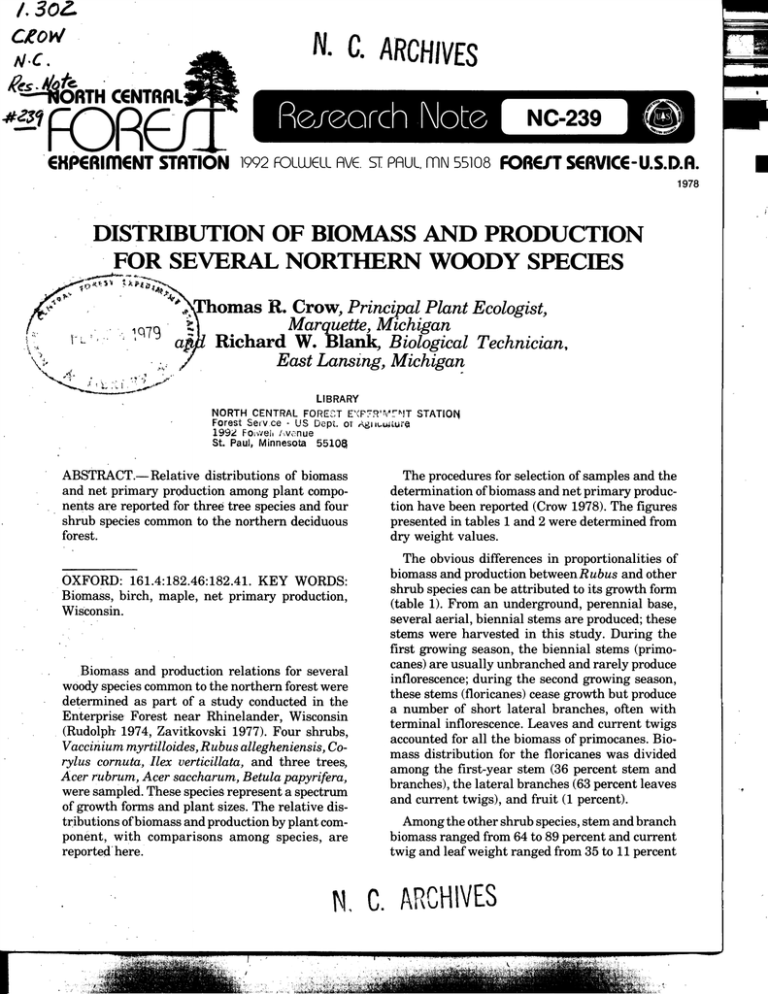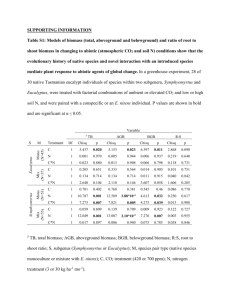cow H / D
advertisement

/. cow N.C. H. C.ARCHIVES '_es'_fOCRTH CENTRFII " EHPERII11ENTSTATION 1992FOLWELL AVE.ST. PAUL,mN55108FORESTSERVICE-U.S.D.A. .. 1978 DISTRIBUTION OF BIOMASS AND PRODUCTION FOR SEVERAL NORTHERN WOODY SPECIES 2_-_°" ,_*,,._Thomas R. Crow, Pnnctpal Plant Ecologist, [, _ • _qTQ _t . Marquette, Michigan ii Y-:-_ ': : "" " a_fl Richard W. Blank, Biological Technician, _(,, .:,_ ,_ East Lansing, M_ch_gan LIBRARY ' NORTH CENTRAL FORE_IT E'<PF,R'rCEHTSTATION Forest Serv.ce - US Dept. oi ,_gJ_i.u_'_ 1992 Foiwet, /_,vanue St. Paul, Minnesota 5510_ ABSTRACT._ Relative distributions of biomass and net primary production among plant components are reported for three tree species and four shrub species common to the northern deciduous forest, OXFORD: 161.4:182.46:182.41. KEY WORDS: Biomass, birch, maple, net primary production, WiSconsin. ' Biomass and production ' relations for several woody species common to the northern forest were determined as part of a study conducted in the • Enterprise Forest near Rhinelander, Wisconsin (Rudolph' 1974, Zavitkovski 1977). Four shrubs, Vaccinium myrtilloides, Rubus allegheniensis, Corylus cornuta, Ilex verticillata, and three trees, Acer rubrum, Acer • saccharum, Betula papyrifera, were sampled. These species represent a spectrmn of growth forms and plant sizes. The relative distribufions ofbiomass and production by plant component, with comparisons among species, are reportedhere, . The procedures for selection of samples and the determination ofbiomass and net primary production have been reported (Crow 1978). The figures presented in tables 1 and 2 were determined from dry weight values. The obvious differences in proportionalities of biomass and production betweenRubus and other shrub species can be attributed to its growth form (table 1). From an underground, perennial base, several aerial, biennial stems are produced; these stems were harvested in this study. During the first growing season, the biennial stems (primocanes) are usually unbranched and rarely produce inflorescence; during the second growing season, these stems (floricanes) cease growth but produce a number of short lateral branches, often with terminal inflorescence. Leaves and current twigs accounted for all the biomass of primocanes. Biomass distribution for the floricanes was divided among the the first-year stem (36 percent stemleaves and branches), lateral branches (63 percent and current twigs), and fruit (1 percent). Among the other shrub species, stem and branch biomass ranged from 64 to 89 percent and current twig and leaf weight ranged from 35 to 11 percent N, C.ARCHIVES Table .• 1.--A summary of mean dimensional and functional relations for shrub species sampled in the Enterprise Forest Vaccinium myrtilloide$ Item Rubus alleghenlensis . Corylus cornuta Ilex verUcillata Table 2._A Item summary of mean dimensional and functional relations for tree species sampled in the Enterprise Forest Acer rubrum Acer saccharum Betula papyrifera primocanes floricanes Sample number 69 62 41 70 20 Basal diameter (ram) Mean 4.0 4.6- 4.9 11.8 14.9 Range 2.3-6.3 2.4-8.2 3.1-7.9 4.0-24.48.6-24.9 • Stem length (cm) Mean 46.4 71.6 56.7 175.1 196.2 Range 30-90 30-137 30-105 42-355 110-290 Biomass distribution (percent of totalaboveground dryweight) Stemand branches 64.5 0 36.3 75.9 89.2 Leaves andcurrent twigs, 35.1 ,100 62.5 23.6 10.7 Fruit <1.0 0 1.2 <1.0 <1.0 Netproduction distribution (percent oftotalaboveground dryweight) Stemand branches .13.8 0 0 11.1 17.6 Leaves andcurrent twigs 84.3 100 99.2 86.4 81.9 Fruit 1.9 0 <1.0 2.5 <1.0 Sample number 23 25 21 D.b.h.(cm) Mean 10.4 10.4 13.7 Range 3.1-24.6 3.5-26.0 3.5-26.3 Totalheight(m) Mean 11.54 11.53 14.04 Range 5.29-18.50 5.50-19.31 5.68-2118 Biomass distribution (percent of totalaboveground dryweight) Bolewood 63.8 64.6 68.8 Bolebark 10.3 8.3 12.3 Branches 20.5 22.2 15.8 Leaves andcurrent twigs 5.4 4.9 3.1 Netproduction distribution (percent oftotalaboveground dryweight) Bolewood 29.7 29.8 36.9 Bolebark 5.5 6.9 8.8 Branches 22.7 18.8 19.9 Leaves andcurrent twigs , 42.1 44.5 34.4 for the small shrub Vaccinium to the large shrub Ilex, respectively. For all species, the fraction of dryweight represented by fruit and fruiting bodies was 1 percent or less of the aboveground biomass, growth by these twigs results in less biomass classifted as current twigs. The branching habit of birch-- few large branches, many short, pendulous branches--could account for the lesser proportions of branch biomass in birch than in the maples. Despite structural differences, the distribution of production among various components was very similar for Vaccinium, Corylus, and I/ex (table 1). Radial growth on stems accounted for only 11 to 18 percent of the aboveground shrub production. The proportions of growth in current twigs and leaves •ranged from 82 to 86 percent of aboveground pl:oduction, Among the trees sampled, bolewood accounted for 64 to 69 percent of the aboveground biomass, •bolebark 8 to 11 percent, branches 16 to 22 percent, and leaves and current twigs 3 to 5 percent (table 2). The distribution of biomass for the two maples Corresponded closely for all components. Birch had more biomass in the stem and less in the canopy than did maple. Distributional differences among species can be explained in part by morphological differences, For example, birch has many short-shoot twigs, each with a cluster of leaves. Minimal apical Size is an important determinant in biomass distribution among components. There was a marked decrease in the proportion of bolebark with increasing stem size, a trend associated with the decrease in the surface-area/stem-volume ratio. Also present was a trend of increasing concentrations of woody tissue with increasing size of a plant. Except for Rubus, the percentage of woody biomass and net production increased from the smallest species to the largest species (tables 1 and 2). Net production in stem and branches together ranged from 55 to 66 percent for the trees and from 11 to 18 percent for shrubs (excluding Rubus). The proportions of belowground and aboveground biomass also varied with plant size. The mean belowground/aboveground ratio for aspen, obtained from the excavation of 20 trees between 2 and 8 cm d.b.h., was 0.24+_0.02 (_SE). For Corylus, a shrub of intermediate size, the mean ratio _ 2 was 1.03_+.0.07(N=49) and for Vaccinium, a small shrub, the meanratio was 1.96_ 0.32 (N = 7). Other reports of belowground/aboveground biomass ratios for trees ranged from 0.2 to 0.3 for young trees to less than 0.2 for large trees (Ovington 1962), and ratios for shrubs range from 0.6 to 1.8 (Whittaker 1962). The average belowground/aboveground ratio for herbaceous species harvested at Enterprise ranged from 2.98 to 4.79 (Zavitkovski 1976). Thus, 19 percent of the total dry weight for the tree was be!0wground, compared to 51 percent for the intermediate shrub, 66 percent for the small shrub, and 75 to 83 percent for the herbaceous species.. • LITERATURE CITED Crow, T. RI 1978. Biomass and production in three contiguous forests in northern Wisconsin. Ecology 59 (2):265-273. Ovington, J. D. 1962. Quantitative ecology and the woodland ecosystem concept. Advan. Ecol. Res. 1:103-192. Rudolph, Thomas D., ed. 1974. The Enterprise, Wisconsin, radiation forest: preirradiation ecological studies. USAEC Rep. TID-26113-P1. Whittaker, R. H. 1962. Net production relations of shrubs in the Great Smoky Mountains. Ecology 43(3):357-377. Zavitkovski, J. 1976. Ground vegetation biomass, production, and efficiency of energy utilization in some northern Wisconsin forest ecosystems. Ecology 57(4):694-706. Zavitkovski, J., ed. 1977. The Enterprise, sin, radiation forest: radioecological ERDA Rep. TID-26113-P2. U.S. GOVERNMENT PRINTING OFFICE: Wisconstudies. 1978--666286/185 3






